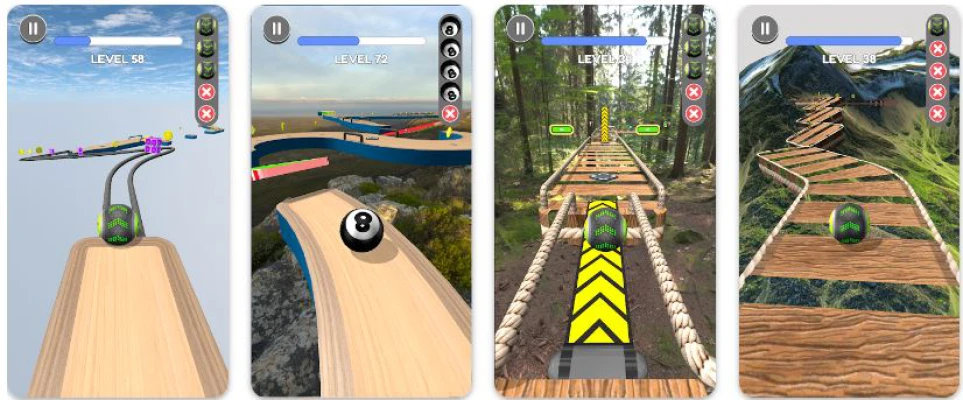
Latest Version
2.16
April 07, 2025
Supersonic Studios LTD
Games
Android
202 MB
4
Free
com.pronetis.ironball2
Report a Problem
More About Going Balls APK 2.16 Unlimited Tickets and Coins
Going Balls game has quickly gained widespread popularity for its combination of easy-to-understand gameplay and difficult challenges. Going Balls is unique due to its skillful combination of physics, reflexes, and spatial awareness, despite its seemingly simple concept of a rolling ball maneuvering through varying levels of difficulty.
Momentum is the central idea of Going Balls. The player guides a ball through different ramps, platforms, and narrow paths, facing obstacles that challenge their timing and accuracy. Different from other endless running games, this game prioritizes fluid, coordinated movement rather than fast-paced action. The mechanics are closely calibrated, so even small changes in momentum can have a big impact on how the ball moves. It is important to master these subtleties to advance to higher.
Every course is designed to motivate players to keep a consistent pace. Players who maintain their speed by skillfully managing their acceleration and deceleration will be rewarded. The quicker and more frequently the ball is in motion, the higher the score players earn, establishing a gratifying mix of risk and reward. Nevertheless, a single misstep could result in the ball being launched off a cliff, immediately terminating the attempt.
The game offers more than just a basic rolling encounter. Going Balls uses a variety of obstacles, all of which are made to interfere with the ball's movement. This may involve rotating obstacles, platforms that move erratically, and narrow passages that demand precise accuracy. The intriguing aspect of these obstacles lies in their strategic placement to manipulate the player's natural responses. For instance, a player may instinctively wish to zoom through a sequence of ramps, but they may come across a thin ledge that necessitates an abrupt decrease in speed.
In terms of appearance, Going Balls uses a simple design, emphasizing neat lines and bold colors. The designs of the levels frequently focus on creating contrast by combining smooth, straight paths with jagged, uneven terrain, indicating a change in the style of gameplay. These visual cues assist players in getting ready for the next parts of the game without the use of text or prompts, preserving an immersive and uninterrupted gameplay. The game's aesthetic decisions are not just about style. The settings and surroundings also change, giving players a feeling of advancement as they navigate through various "worlds," each with their own unique themes.
There is a basic sense of fulfillment when playing Going Balls. It merges an uncomplicated control system - swipe left or right to steer - with a strong strategic aspect. Players need to both navigate the course and maximize their movement. The game promotes perfectionism, as each playthrough is an opportunity to improve tactics and reach a higher score. Moreover, Going Balls achieves a harmonious equilibrium without bombarding players with excessive in-app purchases or intrusive ads like many other mobile games do.
Going Balls game demonstrates the effectiveness of simplicity in designing mobile games. By centering on the basics of momentum and motion, the game provides an experience that is simple to learn yet difficult to become proficient in. Whether you are a casual player seeking entertainment or a serious competitor aiming for top scores, this game provides something for everyone—demonstrating that a captivating experience can be crafted simply with a ball, a track, and the drive for excellence.
Others Version of Going Balls APK 2.16 Unlimited Tickets and Coins
Going Balls APK 2.16 Unlimited Tickets and Coins 2.15
April 04, 2025 202 MBGoing Balls APK 2.16 Unlimited Tickets and Coins 2.6
January 30, 2025 218 MBGoing Balls APK 2.16 Unlimited Tickets and Coins 2.5
January 18, 2025 218 MBGoing Balls APK 2.16 Unlimited Tickets and Coins 2.4
December 20, 2024 216 MBGoing Balls APK 2.16 Unlimited Tickets and Coins 2.3
December 16, 2024 216 MBGoing Balls APK 2.16 Unlimited Tickets and Coins 2.2
November 29, 2024 225 MBGoing Balls APK 2.16 Unlimited Tickets and Coins 2.1
November 14, 2024 230 MBRate the App
User Reviews
Popular Apps










Editor's Choice

















 Games
Games Apps
Apps Android
Android